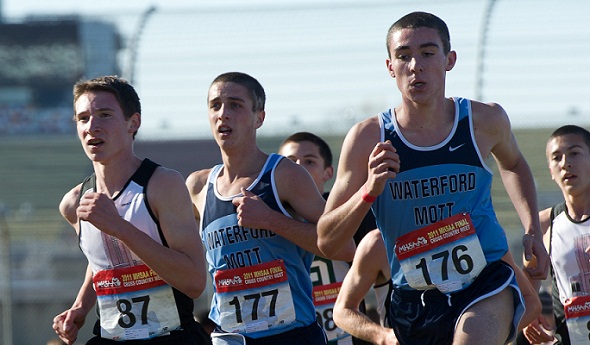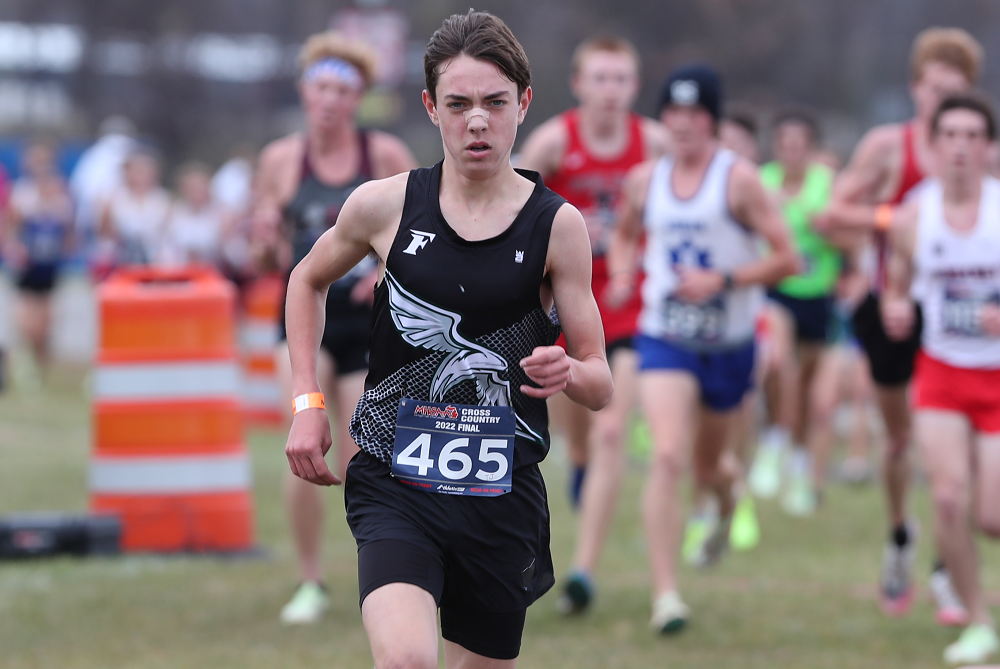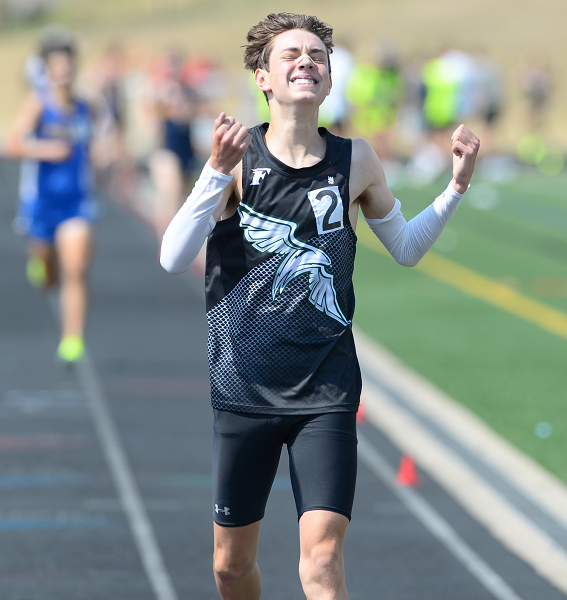
Kicking Into a Higher Gear
October 11, 2012
By Geoff Kimmerly
Second Half editor
Nate Burnand had trouble motivating himself as a freshman. In his words, he was "not a mature student."
Sure, he was balancing two sports during his first semester at Waterford Mott. But he was slacking in the classroom, a shame because he had the potential to do so much more.
We know how much potential because of what he's accomplished over the last two years.
These days, it’s AP economics, U.S. history and comparative politics during the school day and some of the fastest cross country times in the state when class is done. The running achievements came first and the academic success next, and together they’ve provided for an incredible finish to Burnand’s high school career – much like his kick at the end of races that has made him an MHSAA championship contender.
“The positive reinforcement when I have success in running and school, I see the rewards and it makes me want to work harder to do more,” Burnand said. “I think when I made all-state sophomore year in cross country, it clicked for me that I needed to do better things than what I was doing. I had opportunities, and I needed to capitalize on them."
Burnand receives a Second Half High 5 based in part on his 15:21 to win the elite race against a loaded field at Michigan State’s Spartan Invitational on Sept. 14. He also won the Waterford Mott Fall Classic two weeks later in 15:44, and took second last week at the Oakland County Championships.
But his impressive climb to the elite started long before this fall.
He ran his first high school race, in 2009, in 18:16 and finished his freshman season with a personal best of 17:23 while splitting time playing soccer. He decided before his sophomore year to focus solely on cross country, and the surge began.
Burnand opened the 2010 season with a 17:09 and closed it with a 15:45 and 17th place in the MHSAA Division 1 Final at Michigan International Speedway. He improved on that with a 15:38 and sixth place at last season’s Division 1 Final – despite suffering multiple stress fractures that affected how much work he could put in heading into the fall.
Mott coach Ryan Robinson recognized that talent right away, and after Burnand’s freshman year compared him to teammate Scott Albaugh – who went on to win the Division 1 individual title in 2010. The key to this season’s drop has been consistent training; now healthy, Burnand put in 70-mile training weeks this summer, plus swimming pool and plyometric training with his teammates.
And he’s smart with his workload too. After the second stress fracture during spring 2011 forced him to train in the pool alone, Burnand decided he didn’t want to go through that again. He learned his body’s limits and is careful to do just the right amount of work.
“He will do whatever I ask him to do, and then some,” Robinson said. “And he does a lot of research on what other people are doing, what other kids are running, and the times he’d like to run. He’s always trying to do more.”
And as noted above, race success was followed by class success. Burnand had a 2.4 grade-point average after his freshman year, not because he struggled with the material but because he didn’t put in enough effort. Sophomore year was about breaking habits, and the comeback was on.
Burnand scored a 3.8 GPA as a junior, bringing his cumulative up to 3.0. He has the three Advanced Placement classes this fall, and would like to study economics or politics in college.
“I always knew I was capable of this. I wanted to be a good student, but I didn’t have the motivation,” he said. “I knew I wouldn’t be able to have a running career if I didn’t keep up in school.”
That's the plan, and he’s making it difficult for others to keep up. Robinson said Burnand executed strategy perfectly at MSU. Burnand like to push opponents in small spurts through the middle of races before taking off for the final 1,000 meters. That’s what he did at the Spartan, and over the final 500 Burnand had energy that his opponents couldn’t match.
As a junior, he had to convince himself he could finish those races in first. But during that summer training he began to believe, and after a few weeks staying with family and training on the hills surrounding San Francisco, he saw dividends.
Like with his studies, the more goals he hit, the more goals he chased.
“I think my confidence has gone up,” Burnand said. “Over the summer, I was running everything fast, hitting my mileage goals, not struggling, and I think it just started clicking. I had a feeling things were going to happen this year.”
PHOTO: Waterford Mott's Nate Burnand rounds a turn during last season's MHSAA Division 1 Final at Michigan International Speedway.

Freeland's Hansen Not Focused on Joining All-Time Greats - But On His Way
By
Paul Costanzo
Special for MHSAA.com
September 29, 2023
The goal written on Matt Kaczor’s Post-It Note was sub-15 minutes, 15 seconds. That’s what the Freeland cross country coach was hoping for from star runner TJ Hansen during his junior season.
 Kaczor tore it up after seeing Hansen run a single race this fall.
Kaczor tore it up after seeing Hansen run a single race this fall.
“Knowing what he did over the summer and where he was at, seeing what his 1,600 (meter) and his mile got down to, I had a feeling he could get under 15:30 quickly,” Kaczor said. “After the first race, I looked at my assistant and was like, ‘I’ve gotta rip up that Post-It Note. I don’t think our goal is on the level of where he’s at right now.’ At first, it was break 15:15. Once I saw him race at the Under the Lights (on Aug. 18 at St. Johns), I was like, ‘Yeah, he’s going sub 15.’”
Hansen ran 15:39.6 in that first race, and on Sept. 7, in Shepherd, he ran 15:13.9 to meet the goal written on the now-shredded Post-It Note.
This past Saturday, he ran 15:03.7 at the Cadillac Veterans Serving Veterans Invitational. It’s the fastest time recorded in Michigan this year, and a signal that Kaczor might be filling out a new Post-It Note before the season is out.
“The sub-15 barrier, that’s been something on my mind for a while,” Hansen said. “Now that I’m edging closer and closer to that, it’s been exciting. With how heavy my training has been, I wouldn’t expect (to have run this fast this early). Being able to run the times I am really paints the picture for what’s ahead.”
Hansen came into the season already regarded as one of the elite distance runners in the state. He won the 3,200 meters at the MHSAA Lower Peninsula Division 2 Track & Field Finals this past spring. He’s also finished all-state (12th and fifth, respectively) the past two seasons at the LPD2 Cross Country Finals.
His current trajectory, however, would put his name near some of the state’s all-time greats. But that’s not something Hansen is focusing on.
“I really don’t like to compare myself to others,” he said. “I don’t focus on that. I try to be the best TJ Hansen that I can be. The best version of myself.”
Focusing on himself is almost necessary for Hansen, as he’s spending a lot of time during his races running by himself.
At each of the big events Freeland has run in this season, Hansen has finished at least 20 seconds ahead of his nearest competitor. That includes all divisions of the Duane Raffin Festival of Races in Holly.
In Cadillac, where Hansen ran his current best time, he was a full minute ahead of the rest of the field.
 “He’s just a special athlete,” Kaczor said. “I can’t see Freeland having someone like this in a while. He’s a generational talent. What’s crazy is, I had the school record when he was a freshman. He and Braden (Honsinger) broke it last year. But TJ has now dropped that school record (set in 1998) by almost a minute.”
“He’s just a special athlete,” Kaczor said. “I can’t see Freeland having someone like this in a while. He’s a generational talent. What’s crazy is, I had the school record when he was a freshman. He and Braden (Honsinger) broke it last year. But TJ has now dropped that school record (set in 1998) by almost a minute.”
Hansen’s achievements have already put him on a path to run at the next level, which is something of a family tradition.
His older sisters Peyton and Kiera are track & field athletes at Wayne State and Eastern Michigan, respectively. Their parents, Tim and Pam, were track & field stars at Central Michigan.
TJ has drawn the attention of coaches around the country, including from Michigan, Michigan State, Wisconsin, Tennessee and Colorado.
Having family members who know the process is a help for Hansen, and he said they’ve all been good about allowing him to choose his own path, whatever that may be.
“He’s from a good family that knows how to work and knows how to get things done,” Kaczor said. “He knows that if he puts in the work, he’s going to be at a good spot.”
While Hansen admits it can be a bit overwhelming, he’s using it as motivation to run faster and continue to put his name out there.
Also serving as motivation is 2022 Division 2 champion Connell Alford of Chelsea. Alford is among the elite group of runners in Michigan who have broken the 15-minute mark, doing it twice a year ago.
He currently has the state’s second-best time behind Hansen’s this year, running 15:09.1 at the MSU Invitational on Sept. 15.
“Whenever I see him drop a time, my main goal is to run faster,” Hansen said. “Whenever I see him run a good time, that motivates me to work hard.”
The two won’t see each other until the MHSAA Finals on Nov. 4 at Michigan International Speedway. It’s an opportunity Hansen is excited for, as it’s a chance to race and be pushed toward the lofty goals he’s set for himself. Kaczor is excited about it, too, even if it might mean having to replenish his supply of Post-Its.
“We don’t talk about winning the state title; we talk about making sure that we have great races on those days,” Kaczor said. “We can’t control how somebody else runs. It’s a matter of can we, if the weather is right and the course is in good condition, can we be one of the few guys that has run in the 14s on that course? That’s the goal. Put yourself in some great categories with those upper echelons and the greats of all-time.”
 Paul Costanzo served as a sportswriter at The Port Huron Times Herald from 2006-15, including three years as lead sportswriter, and prior to that as sports editor at the Hillsdale Daily News from 2005-06. He can be reached at [email protected] with story ideas for Genesee, Lapeer, St. Clair, Sanilac, Huron, Tuscola, Saginaw, Bay, Arenac, Midland and Gladwin counties.
Paul Costanzo served as a sportswriter at The Port Huron Times Herald from 2006-15, including three years as lead sportswriter, and prior to that as sports editor at the Hillsdale Daily News from 2005-06. He can be reached at [email protected] with story ideas for Genesee, Lapeer, St. Clair, Sanilac, Huron, Tuscola, Saginaw, Bay, Arenac, Midland and Gladwin counties.
PHOTOS (Top) Freeland's TJ Hansen leads a pack during last season's LPD2 Final at Michigan International Speedway. (Middle) Hansen enjoys a moment of exhilaration after winning the 3,200 this spring at the LPD2 Finals at Ada Forest Hills Eastern. (Top photo by Carter Sherline/Run Michigan; middle photo by Dave McCauley/Run Michigan.)

